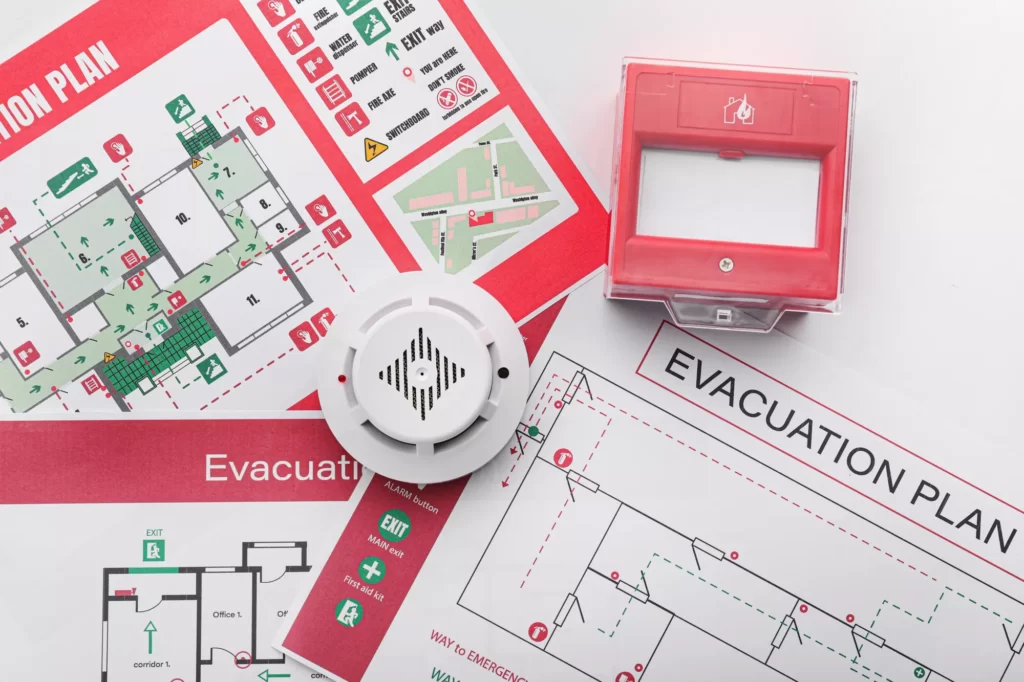4 Min Read | Jun, 01, 2023
5 CRUCIAL CONSIDERATIONS FOR YOUR HOTEL PROPERTY’S ASSEMBLY POINT PLAN

Is your hotel prepared to handle any emergency? On the off-chance that a fire breaks out or there’s a natural disaster, it’s important to get staff as well as guests to safety as quickly as possible. To ensure a swift and streamlined evacuation, you need a clear evacuation strategy—and that means designating a safe and convenient assembly point.
In the event of an emergency, a well-designed assembly point plan can help save lives.
Let’s have a look now at five crucial action items you can put into place to optimize your property’s assembly point plan. This to-do list will help you establish effective emergency protocols and train your team about safe evacuation procedures.
1. Decide on a Clear Chain of Command
In an emergency, even the calmest among us can react unpredictably—and panic is the last thing you need in a high-stress situation! That’s why it’s critical to put someone in charge of assessing and responding to the emergency. It might be a specific individual, such as the hotel manager or a designated safety officer. You could even create a team of trained staff members to manage the evacuation process—especially if you’re potentially dealing with large numbers of people.
A good emergency exit plan needs a clear chain of command. For example, some staff may be responsible for mobilizing guests and leading them to assembly points, while others may be assigned to conduct headcounts of guests and staff and notify emergency services.
Once you’ve established exactly who’s doing what, it’s much easier to stick to the evacuation plan—and for hotel management to ensure everyone’s safety.
2. Differentiate Shelter-in-Place vs. Evacuation

In some circumstances, it’s safer to stay indoors than to evacuate. This kind of emergency response strategy is called “shelter-in-place.” In particular, it’s useful in cases of external emergencies, such as extreme weather events.
Creating an evacuation plan also involves assessing whether it would be safer to evacuate or to shelter at the hotel property. Here, you should consider the type and severity of the emergency.
If there’s no imminent danger, sheltering in place may be the best option. However, in the case of a fire or other emergency that makes it unsafe to remain inside the building, evacuation would be necessary.
Establish a well-defined plan for both shelter-in-place and evacuation scenarios, and train staff to assess these situations and take the appropriate action. For example, you’ll need to identify a safe indoor assembly point to use when sheltering on the premises. Ideally, it shouldn’t have windows or stacks of large objects that could fall and hurt someone.
Also, bear in mind that there may be people from outside the property looking to get off the road and shelter with guests and staff. In addition, consider communication devices—such as alarms and public address systems—to alert people to the emergency and provide instructions on what to do.
3. Prepare for Various Scenarios
More than one type of emergency can happen at your hotel. To prepare for several possible scenarios, start by asking some basic questions:
- Which areas are at the greatest risk of fire?
- How would you evacuate injured or special-needs guests?
- What if X happens? (In this case, X could be unforeseen emergencies, such as a bomb threat, an accident, theft, vandalism, an epidemic, and so on.)
- This exercise can help you avoid any mishaps during the evacuation. It also helps staff members understand how to react to challenging circumstances.
Make sure every employee knows the evacuation routes and has a thorough understanding of how to deal with a variety of emergency situations without panicking. Furthermore, it’s worth regularly reviewing your assembly point plan and chain of command to ensure they remain up-to-date and optimally effective.
4. Have a Communication Plan Laid Out
An emergency scene can be very chaotic. Sometimes, team members receive contradictory instructions from different sources, leading to confusion as well as safety risks. This is why providing clear communication is vital when managing a crisis.
That said, how do you make sure your emergency communication is streamlined and unambiguous? Consider designating a single point of contact—or command center—for the emergency response team. As a result, all information and instructions can be relayed from one central location. Furthermore, your staff will have a good idea of who to contact and how to get the facts they need.
With the right emergency communication system, you’ll be able to send critical information and instant notifications on active threats. WrkSpot’s hotel management software has an intuitive emergency communication tool that makes emergency communication seamless. All it takes is a few clicks to notify the entire team—within seconds.
Once the system is in place, train your communications team to disseminate correct and up-to-date evacuation information.

5. Conduct and Reinforce Staff Training
Conducting regular “fire drills” has more than one benefit. Repeated rehearsals lead to better staff preparedness. In addition, they reduce the likelihood of panic.
Through repetition, employees learn how to respond calmly in stressful situations. This is important because guests depend on staff members to lead them safely to the assembly point.
For example, in the event of a fire (which can spread rapidly), a positive outcome is more likely with well-trained staff who know exactly what to do. To achieve this, however, you’ll need a comprehensive emergency evacuation training program covering multiple aspects—including identifying emergency exits, evacuation routes, and emergency assembly points. With proper training and regular practice, each individual will be adequately prepared to deal with a real emergency.

It’s helpful to conduct training using real-life scenarios, simulations, and role-playing exercises. This way, staff members will better understand and retain the information.
Helpful Tip: you can use the WrkSpot app to set up a core group chat to execute training plans and boost operational efficiency.
Prioritize Safety Preparation With WrkSpot
Developing an assembly point plan is a big step toward prioritizing staff and guest safety. People tend to panic and scatter in an emergency. However, with a good plan, you can prepare step-by-step rescue and response procedures that will ensure the best outcome.
WrkSpot provides comprehensive panic solutions that enable staff to notify the entire team in seconds and ensure compliance with procedures. Using the WrkSpot app, you manage day-to-day hotel operations and deliver critical communications to each employee to ensure their safety.
WrkSpot is your one-stop solution to faster emergency responses and more effective communication delivery during crisis events. We can help you keep your staff and property safe. Book a demo to find out how.
